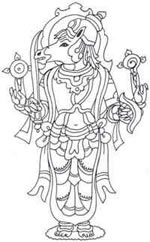The Ten Avataras 10
A Psychological Study of the Evolution of Humankind
Swami Satyadharma Saraswati
10. KALKI AVATARA
 Kalki
is the tenth and last avatara, who will come at the end of Kali yuga.
The advent of Kalki is described in the Mahabharata as well as in the Kalki and Bhavisyat Puranas. Kalki appears as a hero of great prowess,
dressed in black, riding upon a white horse, which is also an avatara
in itself. Kalki carries a sword with which he strikes down all evil and
battles for the cause of righteousness. Here the Lord descends as the
warrior Kalki, and the horse, pervaded by his essence, is his inseparable
and most characteristic attribute. The power embodied in the horse equates
with the power of the Lord. Kalki comes at the end of the Kali yuga to
destroy the creation that has sunk into an abyss of corruption, after
which it will be created anew.
Kalki
is the tenth and last avatara, who will come at the end of Kali yuga.
The advent of Kalki is described in the Mahabharata as well as in the Kalki and Bhavisyat Puranas. Kalki appears as a hero of great prowess,
dressed in black, riding upon a white horse, which is also an avatara
in itself. Kalki carries a sword with which he strikes down all evil and
battles for the cause of righteousness. Here the Lord descends as the
warrior Kalki, and the horse, pervaded by his essence, is his inseparable
and most characteristic attribute. The power embodied in the horse equates
with the power of the Lord. Kalki comes at the end of the Kali yuga to
destroy the creation that has sunk into an abyss of corruption, after
which it will be created anew.
The Puranas describe Kali yuga as a time of darkness when people are governed by lower impulses. There is a rise of artha and kama with the disappearance of dharma and moksha. Towards the end of this period it is said that drought and famine will prevail. Sensory satisfaction will be the goal of life. Ethics will be of no concern. Money will determine nobility of birth, character and conduct, and will decide what is just and right. Children will desert their parents. Vedic studies will lose their importance. Students will not strive to learn, and will lack purity in thought, word and deed. Scholarship will depend on one’s ability to talk a lot. People will preach dharma without realising it in their own lives and actions. Householders, instead of sustaining renunciates, will take to begging. Forest dwellers will have a fascination for living in towns. Sannyasins will hanker after wealth.
We are presently living at the beginning of Kali yuga, but many of these signs have already become evident within society. The social order is in a rapid state of decay. The family unit is dissolving and social traditions are being lost. Children do not support their parents. Growing numbers of homeless people are found in most cities around the globe. With the increase in population and mechanisation, the cost of living rises higher. In law courts, money determines conviction. The influence of drugs, alcohol and crime is unrivalled. Television, books and art demonstrate the social desire for sensuality, vulgarity and materialism.
This is the situation at the beginning of Kali yuga and as it advances all the dark aspects will become more accentuated. Kalki will descend at the end of this time, when things can degenerate no further, as a supreme act of the Lord, to draw creation back into Himself. Kalki will come dressed in black, representing destruction, and riding a white horse, representing spiritual power. In his hand he will hold aloft a naked sword, like a blazing comet, with which he will destroy the negative elements. When his work is complete, the white horse he rides will stamp on the earth with its right forefoot. With this, the tortoise supporting the world will drop into the deep and the world with it. Thus the present chaturyuga, or period of four consecutive ages, will end and a new era will begin.
The coming of Kalki represents the period of transition at the end of an epoch, when the world order becomes totally corrupt, beyond redemption, before the coming of an entirely new age. At the end of each chaturyuga, the Vedas are swallowed up by Time, bringing about dissolution before the start of a new chaturyuga. During the coming ages, the Lord will again appear in the world as divine incarnations at various times to support and guide the evolution of consciousness and maintain the world order.
This is the concluding article in this series.